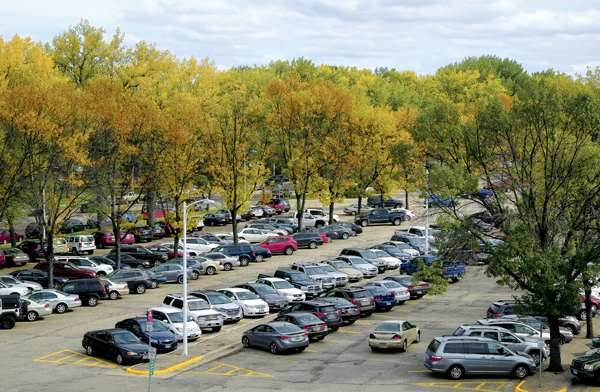Parking changes to continue
Parking services works to meet the needs of an evolving campus
October 18, 2017
Like any student running late to class knows: as campus evolves, so too must parking. Over the next ten years, the University of North Dakota plans to make many changes to its buildings and layout. Parking considerations are an important aspect being considered in the notorious master plan.
“It’s a moving piece right now,” Bob Shindele, Director of Parking and Transportation, said of the university’s current parking layout.
The latest changes included the start of construction on a parking lot near Robin Hall to primarily serve aviation students, faculty and staff. There were also alterations to the zoning of the Columbia Hall lot. The total number of student spaces did not change, but Parking Services rearranged spots in the “A” (Administration) and “A/H/S” (Administration, Housing and Students) sections to consolidate.
Shindele said Parking Services is looking into increasing student parking space at Columbia because more student groups and services have been moving their operations to the building. These changes could take some time, however.
“We’re really careful so we just don’t react fast and then have to change it again,” Shindele said. “(…) We just can’t say, ‘Yeah, let’s do it,’ and a month later it’s like ‘Oh no, it didn’t work’ and then have to go back. It’s two levels of confusion.”
Changes have yet to be made to the zoning in the parking ramp located near the Memorial Union, but Shindele said in the future, there is the possibility of adding more pay-as-you-go spaces for visitors.
As departments and organizations move across campus, Parking Services has been keeping in close communication with the Master Planning Committee and been diligent in collecting their own data to determine any pressing parking needs. One vital tool in this process is the License Plate Reading (LPR) system, introduced last year.
“With our LPR system, if we know there are 100 spots in the lot, we go through, we read 50 plates, we know we have 50 percent occupancy in that lot,” Shindele said. “We can be a lot more accurate in our data.”
The LPR system has also made Parking Services more accurate in issuing citations, defending themselves against citation appeals and cracking down on parking permit sharing. Shindele understands that this may frustrate students, but said, “If we issued zero citations we’d be happy.”
Though this may be true, there is no denying that Parking Services’ funding does rely, in some part, on proceeds from citations. They receive zero appropriated funds from the state and are completely self-funded. It is a closed system; their income comes mostly from parking pass fees, citation fees and money generated from special event parking.
“All of that money comes right out of parking back into the lots,” Shindele said. “If there’s 10 bucks left over, we fill a pothole.”
Students, faculty and staff should not expect any sudden shifts in parking lot zoning as the year goes on, but there will certainly be major changes moving forward.
“It’s being evaluated right now as to what (it) will be,” Shindele said. “You know, there’ll be some work around campus next summer.”
Diane Newberry is the news editor for Dakota Student. She can be reached at diane.newberry@und.edu


